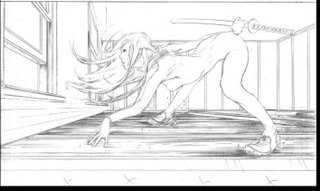"Why did you choose T'Challa's [Black Panther's] first love over his ex-fiancee, Monica Lynne?
RH: Because Superman should be with Wonder Woman, not Lois Lane..."
(Hat-Tip to West)
"Why did you choose T'Challa's [Black Panther's] first love over his ex-fiancee, Monica Lynne?
RH: Because Superman should be with Wonder Woman, not Lois Lane..."
But comics *art* different from "regular" art.I'm not sure what the point of Rubens-Ingres art tangent she started off with was, but comics art is meant to present the best picture to support the story. Bottom line.
To compare comics to "regular art", you might look at the difference between Ingres and PP Rubens.
Ingres painted all of his "odalisque" paintings so that, if the woman existed in real life, she would have to have up to three extra vertebre. In the "Grand Odalisque", this is most true. The sitter is portrayed as disproportionate in order to convey the artist's personal aesthetic.
Rubens does much the same. His female sitters aren't technically real. They portray an aesthetic of beauty for the time and portion of the world in which he lived. Most of Rubens sitters are heavy hipped with a slightly rotund belly. However, Rubens portrays a slightly more realistic woman. She has wide hips, a belly, a more realistic bosom perhaps. But she's still just an image, a style of beauty.
I'm not sure which artist you're referring to when you envision a non sexualized or aestheic or realistic view of the natural form. Art does not depict life. Art depicts a vision of the artist. Picasso painted multitudes of women, but they were in his vision. He painted the parts he wished to portray in a way that he found aesthetically pleasing. Degas and Manet painted figures of an irreputable position, but in a aesthetically pleasing light, where they would not be under the usual circumstances.
Comic art is much the same. The artist isn't looking to recreate life. He's looking to present an aesthically pleasing subject. Whether that subject has breasts that are too large or legs that are too long, or a chest that is far too rectangular and a waist that is strangely small in comparison. It isn't life they are expected to depict, but a cartoon image of pleasure.
How many cartoons do you see that are real? Anime babes with huge eyes and strangely colored hair. A tomcat that stands on two legs. A sponge in clothing. Pink and purple ponies with glitter hair that talk.
Comics are just cartoons. They're images that reveal a certain brand of entertainment.

As you can see, there are slight changes from the layouts… panel three totally changed, and went for a more dynamic landing in the last from the layout version.

[...] went for a more dynamic landing in the last [...]
"I saw the movie when I was seven and I was absolutely thrilled by Leia -- what a wonderful character," says Amira Sa'id, a dancer who has used a Leia bikini in her performances. "Jabba put her into the outfit to humiliate her, but Leia was such a strong character, her will made the costume empowering."I wouldn't say it was sheer force of will so much as her actually using the chain attached to the metal outfit to strangle the amorphous bastard who put her in the ridiculous thing to death.
Oh, and if a creator brings his wife to a show, don't hit on her. If he ends up slugging you and busting his hand, he'll produce fewer comic books and everybody loses in that deal. And don't offer to let him ball your sister -- especially if his wife is in earshot. That can cause all kinds of problems.Thank you, Erik, valuable advice indeed.
Ms. Hilary Goldstein & Mr. Richard George,I'll be sure to inform you of any reply.
I read your "Ten Books for Your Girlfriend" article, and I regret to inform you of a terrible error that was missed.
The end of the article was cut. I read through the whole thing and didn't see the punchline where you let everyone know you were kidding, that they're supposed to talk to their significant other and find out what kinds of stories they like before making recommendations. It's an awful thing to omit, because without it, people might think that you're serious.
It seems obvious to me, but apparently no one else has brought it up because here we are nearly a month later and the last paragraph is still not there. You may want to discuss this with your editor.
Thank you,
-- Lisa Fortuner
 My writing skills need work. I'm apparently able to entertain well enough, but when it comes to the true purpose of writing -- getting the message across, I've been falling short.
My writing skills need work. I'm apparently able to entertain well enough, but when it comes to the true purpose of writing -- getting the message across, I've been falling short.When you embrace this cover, you're not embracing a noble view of womanhood. You're embracing the view that a woman can only be noble if she rejects and battles against the sexuality that a male-dominated culture finds threatening.